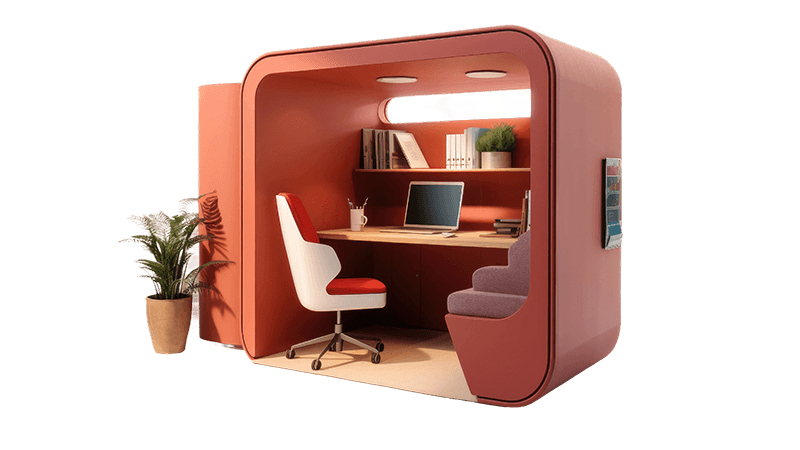To enhance the health and wellbeing of employees in the workplace, employers need to prioritise their physical, mental, and emotional wellness. Creating a positive work environment boosts productivity and employee satisfaction, reduces absenteeism, and fosters overall wellbeing.
In a recent webinar hosted by Steelcase, titled Redefining Wellbeing, participants from Steelcase, Moderna, and Little Diversified Architecture (LDA) discussed health and wellbeing in the workplace. In this blog, we highlight some of their insights.
It's no surprise to many of us that in a post-pandemic world, employee wellbeing is suffering. A recent Gallup survey on employee wellbeing revealed that nearly four out of ten U.S. employees report that their work is negatively impacting their mental health. And for work, it's stressful, and sometimes it can be even downright toxic. At the same time, a new Steelcase survey revealed that global leaders say employee wellbeing is their number-one priority for the upcoming year. So why is this disconnect, and how do we support an employee's mental, physical, cognitive, and emotional wellbeing at work?
What is employee wellbeing?
According to Carol Ricard-Rideau, partner and CEO of LDA in Washington, D.C., human health is not the absence of disease. It's about functioning at the highest levels possible that a body is capable of. And supporting those things through salutogenic design features that can help support human health. Because wellbeing has a lot of dimensions to it. Not only physical health, mental health, emotional health, intellectual, and environmental health. So, human health is complex and multifaceted, and it's about operating at your highest potential.
Amy Virgilio, Director of Human Resources at Moderna, defines employee wellbeing as taking care of our employees and their families, inside and outside work, with a holistic lens to ensure we give them the tools for their physical and mental health. She argues that career development is part of wellbeing and ensuring people have thriving workplace careers.
“What's important to recognise is our employees come to us either well or unwell, and then there are things that we as a company can do to them that improve their wellbeing or keep them healthy, but there's also things that the company might do inadvertently that make their wellbeing worse,” says Gary Strelke, Wellbeing Navigator at Steelcase in Grand Rapids.
“We also have elements in the employees' lives outside the workplace that they bring to work. So gone are the days of this separation of work and life. We want to be aware of that and support employees in the ways that the employees need to be supported.”
Why are global leaders prioritising employee wellbeing?
When you boil a company down to the most granular level, it's always a human person performing a task. So many companies focus on the task. They want to ensure it's the most economical, effective, and efficient task lined up with the company's outcome goal. They forget about the person doing that task and all those elements in their lives that might prevent them from doing it well.
So, when employees come to work and are in an environment where their wellbeing is high, every element of the job they touch will improve. Performance and social interaction increase, and people are generally happier and healthier. The whole culture of the organisation can improve if it has healthy employees working for it.
The pandemic has disrupted regular work patterns and led to cocooning, where people have become accustomed to working from home. However, humans are inherently social creatures, and businesses are keen to bring people back into the office. This desire is not just about monitoring productivity but also about fostering a positive and productive culture. Creating culture virtually is possible but challenging, as it lacks the nuances of body language and in-person interaction. There is tension between employees who may see this as a control issue and companies who want to foster relationships and a sense of belonging. Managing an entirely virtual team can be difficult, requiring intentional communication and different management methods. Leaders prioritise employee wellbeing because companies believe a positive culture and stronger relationships can be better achieved in person.
How do you promote mental health?
Mental health has become critical in today's fast-paced and demanding work environments. Employers should encourage employees to prioritise their mental wellbeing by taking regular daily breaks, practising mindfulness techniques, and establishing a healthy work-life balance. Implementing policies that reduce stress and anxiety is essential, such as offering flexible working hours or remote work options. Additionally, providing access to mental health resources, such as Employee Assistance Programs, Wellness Hubs or counselling services, can significantly support employees' mental wellbeing.

Gary Strelke from Steelcase states that establishing a Wellness Hub has contributed to employee wellbeing. “Most companies have an employee assistance provider, but often it's picking up a phone or going to a website to have those engagements. Our employee assistance providers provide us with counsellors and therapists who service our Wellness Hub. They have a scheduled room, and we have employees who will come in and do on-site coaching and counselling with their therapist."
"We even provide a space where employees who worked through the night can come to take a nap. It makes it convenient, and they feel supported in ways that maybe they wouldn't feel supported if this was just a virtual service.”
Foster a supportive culture
A supportive workplace culture is the foundation for employee wellbeing. It makes sense for employers to promote an inclusive and respectful atmosphere where employees feel valued and supported. Encouraging open communication and building strong teamwork is crucial. Employees are people first who thrive on regular feedback, recognising achievements, and celebrating milestones that boost morale and motivation. Offering opportunities for professional development and career growth demonstrates a commitment to employees' overall wellbeing.
Encourage physical activity
Sedentary behaviour can negatively impact employees' health. It is essential to encourage physical activity within the workplace. Employers can offer incentives or rewards for participating in exercise programs or provide on-site fitness facilities. Furthermore, promoting active commuting options like walking or cycling can improve physical health and reduce environmental impact. Incorporating activities into daily routines can improve energy levels, reduce stress, and enhance employee wellbeing in the workplace.
Promote healthy eating
Nutrition plays a vital role in employees' health and wellbeing. Employers can promote healthy eating habits by providing nutritious food options as alternatives in the workplace, such as fresh fruits, vegetables, and whole-grain snacks in vending machines. Organising workshops or educational sessions on proper nutrition can raise awareness about healthy choices. Encouraging employees to stay hydrated and limit their consumption of sugary drinks can positively impact overall health and increase productivity.
Create ergonomic workspaces
Ergonomic workspaces are essential for preventing musculoskeletal issues and improving overall physical wellbeing. Companies should ensure that workstations are designed to support good posture and to avoid discomfort or injuries. According to Carol Ricard-Rideau, after sitting for 30 minutes, the muscles in the lower half of our bodies turn off, and our blood starts moving sluggishly, leaving fatty deposits in our veins. It's the beginning of heart disease. Moreover, our metabolism drops 90%, our good cholesterol 20%, and our necks and spines compress, which is why many of us suffer back problems.
Adjustable chairs, standing desks, monitor stands, and ergonomic keyboards can significantly reduce physical strain. Architect Ricard-Rideau shares four design principles she applies when envisioning workspaces, which she calls the ‘ABCD of wellness’.
A symbolises active design: making it easier to change posture by providing monumental stairs, alternative workstations, and standing desks to improve overall physical wellbeing.

B represents biophilic design. Exposure to nature lowers stress and anxiety levels, improving mental and physical fitness. “So when you get stuck on something, go outside for a five-minute walk. Using plants and natural fabrics in office design also contributes to biophilic design. An element that architects often neglect is the influence of sound. Neurodiverse employees might find running water from a waterfall calming, while others find the sound intrusive. We need to accommodate both when we design workspaces.”

C looks at the community. Anxiety, depression, and other mental disorders have been a part of our society for most of our cultural history, but during the pandemic, it has become much worse. Human connection lies at the heart of human wellbeing. Humans are wired to connect. We seek belonging and attachment to feel worthy and loved. Working in spaces designed to connect people encourages this sense of belonging we desperately seek.

Finally, D illustrates daylight. Human bodies are governed by light. It regulates our blood pressure, hormone levels and general perception of wellness. Light encourages productivity, a positive outlook, and general enthusiasm to be active unless you work in the movie industry.

Implement wellness programs
Comprehensive wellness programs can address various aspects of employee wellbeing. These programs can encompass both physical and mental health initiatives. For example, employers can offer health screenings, fitness challenges, or educational workshops on stress management and resilience-building techniques, as illustrated by the Wellness Hubs at Steelcase that we discussed earlier. Employee assistance programs can provide confidential support for personal or work-related concerns. These employee wellbeing programs demonstrate a company's commitment to the wellbeing of employees and can improve their engagement and productivity.
Promote work-life balance
Achieving a healthy work-life balance is crucial for employee wellbeing. Employers should discourage long working hours and unrealistic deadlines, which can contribute to burnout and poor mental health. Encouraging employees to use their vacation time, respecting their boundaries, and advocating for time off can create a healthy work-life balance.
Architect Ricard-Rideau talks about Gen Z baby boomers and how they prioritise wellbeing. Gen Z was raised by many baby boomers who are also at the stage where they're trying to undo the last 60 years of damage they've done. So, there's a heightened awareness amongst Millennials, Gen Z, and Boomers of work-life balance and their wellness. To effectively prepare for the imminent arrival of the largest generation in the workforce, employers must prioritise employee wellbeing, job satisfaction, and retention. It can be achieved by implementing strategies that promote flexibility and offer adequate support. Such measures create a positive work environment and demonstrate a genuine commitment to employees' health and happiness. Employers can foster a workplace that encourages productivity, engagement, and long-term loyalty by understanding and addressing this new generation's unique needs and preferences.
Train managers on employee wellbeing
Managers play a crucial role in fostering a supportive work environment and promoting employee wellbeing. Providing training programs for managers can equip them with the necessary skills to recognise signs of stress or burnout. Managers should be encouraged to effectively address these issues with empathy, understanding, and appropriate resources. Managers can create a positive and nurturing work culture by prioritising employee wellbeing and leading by example.
Listen to what employees want
Amy Virgilio states Moderna has employed QR codes to ‘listen’ to employees. "We placed static QR codes on furniture and spaces to learn what resonated with employees and what didn't. They could give feedback on that particular furniture design, the atmosphere, the environment, what worked for them and what they disliked.
We used the results in choosing colours and textures to manage a change journey across our business. Employees also responded positively to privacy screens and booths where they can have private conversations, work quietly or make calls.

Conclusion
In this post, we've examined various strategies and findings from Moderna, Steelcase, and Little Diversified Architecture aimed at enhancing health and wellbeing in the workplace. By implementing these strategies, employers can create a warm and professional atmosphere that prioritises the holistic wellbeing of their workforce and avoids burnout. A comprehensive approach to employee health, including addressing physical fitness, emotional health, nutrition, and work-life balance, can foster employee happiness and productivity. Employee wellbeing is morally and strategically essential for long-term success and growth.










